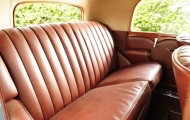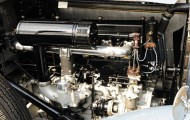1934 Rolls Royce Phantom II Continental Barker Saloon
Chassis number ’57RY’ was built in 1934 specifically for Theodore Cozzika, a prominent Greek industrialist who was lived in Cairo. The records indicate that it was intended ‘for use on Continent and Egypt at very high speeds with fairly heavy luggage’. For more on the history of this car and its owners please go to the news page.
’57RY’ has undergone a comprehensive restoration programme at Taylors UK Ltd of Chichester under the supervision of by Mark Taylor, who in earlier years was workshop foreman at renowned specialists, P & A Wood. The restoration commenced in July 2008, the aim being to preserve as much of the original structure and retain as many original components as possible, returning them to ‘as new’ condition. Work undertaken included removing the wings, running boards, doors, mudguards, windows, all interior trim and woodwork, and then stripping the body back to bare metal prior to repainting it in the original colour scheme.
All items were repaired and refurbished, and new under-wing components fabricated. All chromed fittings were re-plated, all glass replaced, all woodwork refinished and a complete new leather interior installed. The chassis likewise was fully stripped and repainted, and the shock absorbers, prop shaft, brake servo, ‘one shot’ lubrication system and steering box overhauled, the latter by Fiennes Engineering. A new nearside front spring was constructed and all new spring gaiters fitted, while the front brakes were checked/refurbished and the rear brakes relined. All wheels were stripped, rebuilt, repainted, fitted with new wheel discs by Lemarr and shod with new Dunlop tyres. Authentic electrical cable was used for the new wiring loom. Fully stripped and rebuilt, the engine incorporates new cylinder liners, pistons, piston rings and gudgeon pins. The crankshaft was reground and crack tested, as were the con-rods, after which it was re-nitride hardened. The slipper drive was rebuilt and the entire reciprocating mass re-balanced. The cylinder head was refurbished, skimmed, and rebuilt with new valves, guides and seats. A new camshaft to the latest standard has been installed together with Professor Ken Brittan’s modified cam followers for improved oil supply. All nickeled parts were re-plated and the cylinder block and head repainted. The dynamo, magneto, water pump, distributor and Autovac were overhauled, new engine and hot spot exhaust systems installed.
Turning to the ancillaries: all lights were refurbished and the Lucas P100 headlamps rebuilt, re-silvered and re-chromed. A ‘new’ PLG 430 spot lamp was fitted and an original Stephen Grebel spot lamp sourced, while all instruments and the switch plate have been overhauled. Described in Raymond Gentile’s authoritative work, ‘The Rolls Royce Phantom II Continental’ and illustrated on page 219, ’57RY’ is offered fresh from its recently completed restoration and is in excellent condition, having covered a mere hundred or so shake down miles and is now ready to be enjoyed.
Additional Information about the Phantom II
The Phantom II was introduced in 1929 as a successor to the New Phantom (retrospectively known as the Phantom I) with deliveries commencing in September of that year. Unlike its predecessor, which inherited its underpinnings from the preceding 40/50hp model, the Silver Ghost, the Phantom II employed an entirely new chassis laid out along the lines of that of the smaller 20hp Rolls-Royce. Built in two wheelbase lengths – 144″ and 150″ – this new low-slung frame, with its radiator set well back, enabled coachbuilders to body the car in the modern idiom, creating sleeker designs than the upright ones of the past.
The engine too had come in for extensive revision. The PI’s cylinder dimensions and basic layout – two blocks of three cylinders, with an aluminium cylinder head common to both blocks – were retained, but the combustion chambers had been redesigned and the ‘head was now of the cross-flow type, with inlet and exhaust manifolds on opposite sides. The magneto/coil dual ignition system remained the same as on the PI.
The result of these engine changes was greatly enhanced performance, particularly of the Continental model, and the ability to accommodate weightier coachwork. Designed around the short (144″) Phantom II chassis and introduced in 1930, the Continental was conceived as ‘an enthusiastic owner driver’s car’ and featured revised rear suspension, higher axle ratio and lowered steering column. By the end of production the magnificent Phantom II Continental was good for 95mph. ‘Powerful, docile, delightfully easy to control and a thoroughbred, it behaves in a manner which is difficult to convey without seeming to over-praise,’ declared The Motor after testing a PII Continental in March 1934.
Highly favoured by prominent coachbuilders, the Phantom II chassis provided the platform for some of the truly outstanding designs of its day and this Continental model wears handsome saloon coachwork by Barker & Co, of London, one of the finest of all British coachbuilders and a firm associated with Rolls-Royce from the latter’s earliest days. Old established coachbuilders, Barker had shown an example of their work to the Hon C S Rolls as early as 1905; indeed, so impressed was he that the firm was viewed as the ‘official coachbuilder’ to Rolls-Royce for the next 25 years.












